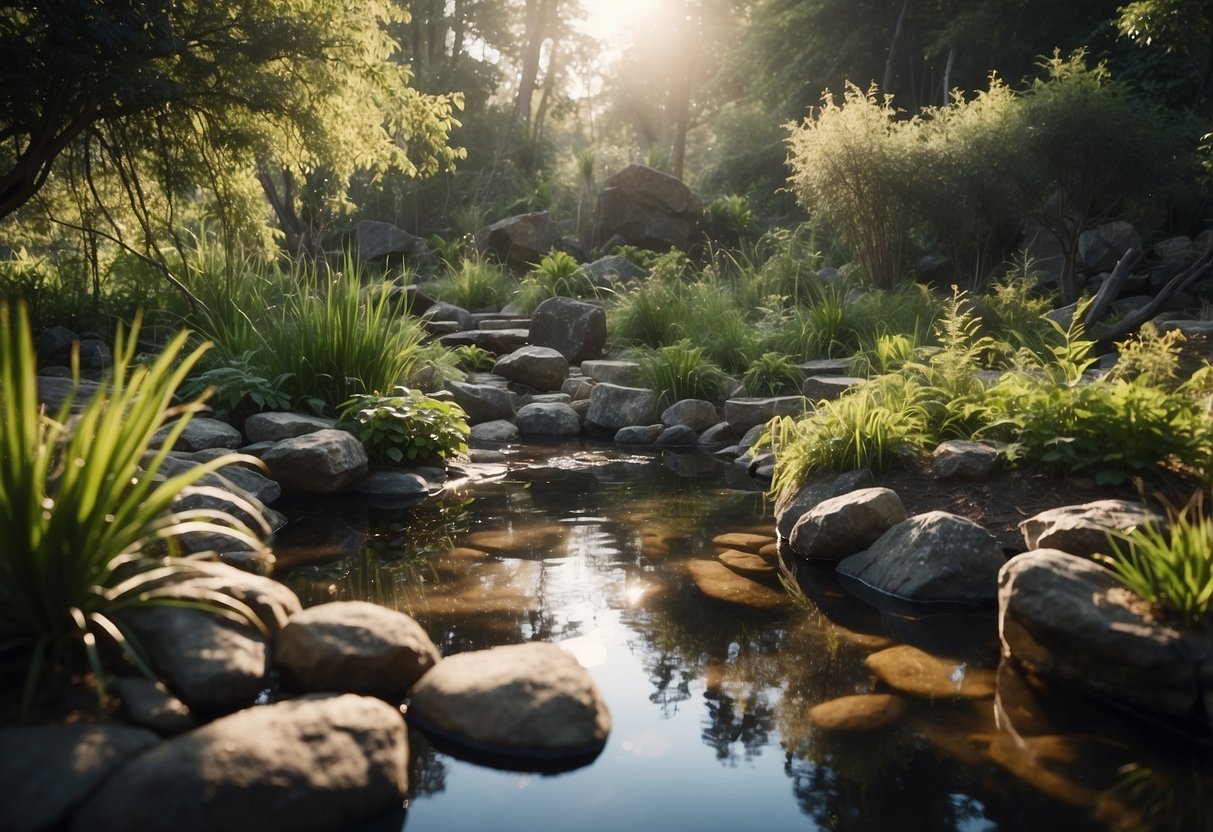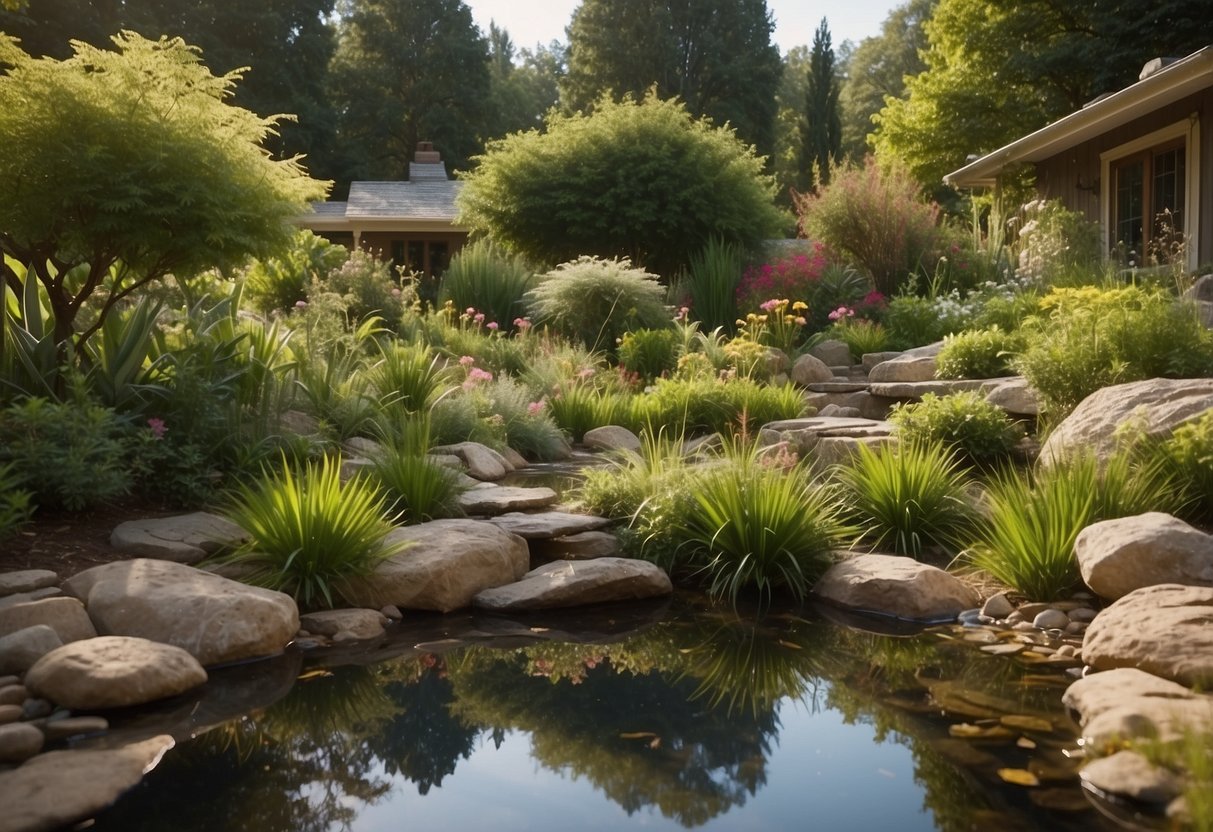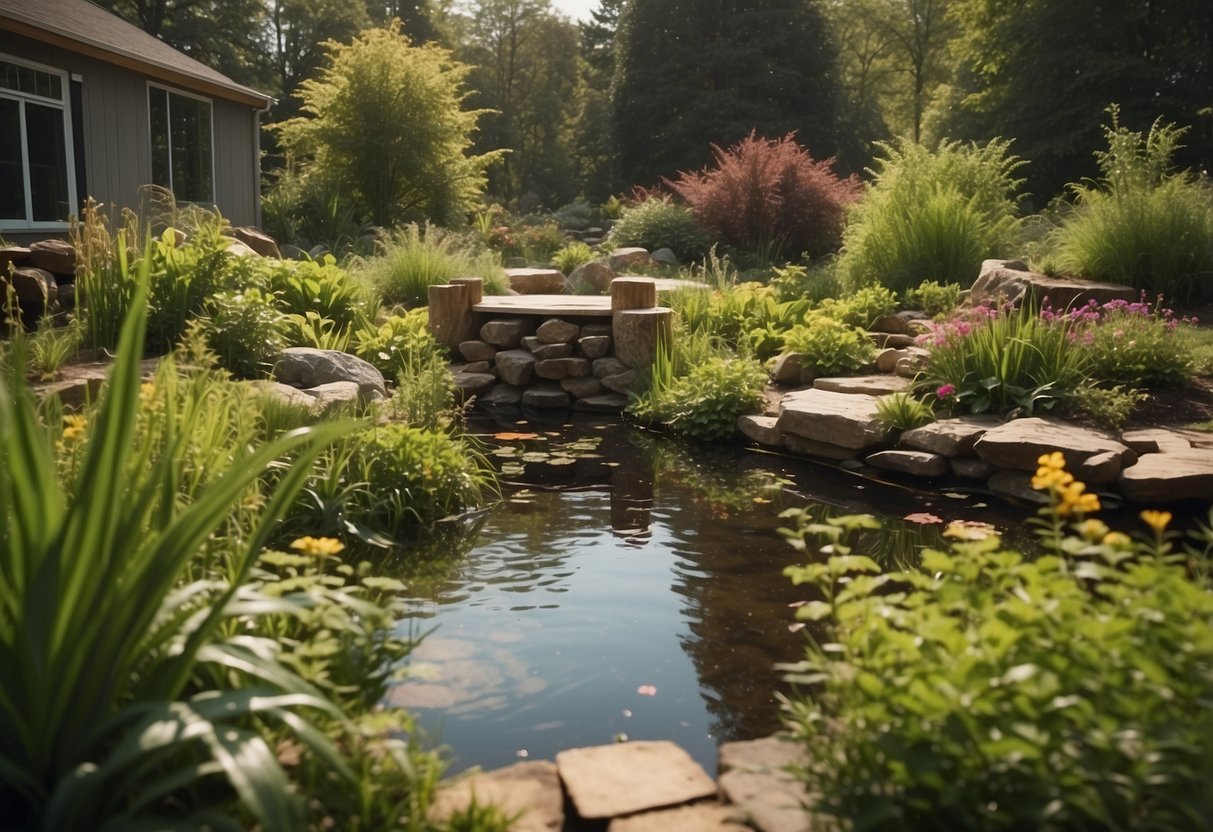Wildlife Habitat Creation:
Easy Steps to Attract Frogs to Your Yard
Frogs are amazing creatures that can add life and charm to your backyard. By creating a frog-friendly habitat, you can enjoy their presence and help protect these important amphibians.
You can make a frog habitat by adding a small pond, letting grass grow tall, and planting native vegetation.

Creating a frog-friendly space is easier than you might think.
Start by setting up a water source, which can be as simple as a container filled with water or a small pond.
Add rocks, logs, and plants to give frogs places to hide and rest. Then, avoid using chemicals in your yard, as these can harm frogs and other wildlife.
Native plants are key to a thriving frog habitat. They attract insects for frogs to eat and provide natural shelter.
Mix ground cover, shrubs, and trees to create a diverse garden that frogs will love.
With these steps, you’ll soon have a backyard that’s both beautiful and frog-friendly.
Key Takeaways
- Create a water source and add hiding spots with rocks and plants
- Use native plants to attract insects and provide natural shelter
- Avoid chemicals and pesticides in your frog-friendly garden
Understanding Frogs and Their Needs
Frogs are amazing creatures that play a vital role in our ecosystems. These amphibians need specific conditions to thrive in your backyard or garden.
Frogs require both water and land to survive. They lay their eggs in water, where tadpoles develop. As adults, many frogs spend time on land but return to water to breed.
Water is crucial for frogs. They need clean, chemical-free water sources like ponds or shallow pools. Frogs absorb oxygen through their skin, so water quality is very important.
Here are some key needs of frogs:
- Moisture: Frogs need damp environments to keep their skin moist
- Shelter: They require hiding spots like rocks, logs, or dense plants
- Food: Frogs eat insects, worms, and other small creatures
- Safety: Protection from predators and harmful chemicals is essential
Native plants are great for creating frog habitats. They provide food and shelter while attracting insects that frogs eat.
Frogs are sensitive to changes in their environment. Pollution, climate shifts, and habitat loss can harm them. By creating a frog-friendly space, you can help protect these valuable animals.
Designing Your Frog-friendly Habitat
Creating a frog-friendly habitat involves careful planning and consideration. You’ll need to choose the right spot, add water features, and select plants that provide shelter and breeding areas.
Choosing the Right Location
Pick a shady area in your yard for your frog habitat. Frogs like cool, damp places. Look for spots near trees or bushes, as these give natural shade and protection.
Avoid areas with lots of foot traffic or noise. Frogs are shy and need quiet spaces. Make sure the spot is away from roads to keep frogs safe.
Check that the area has good drainage. Frogs need moist soil, but not waterlogged ground. A slight slope can help with this.
Incorporating Water Features
Water is crucial for frogs. You can add a small pond or even a large container filled with water. Make sure it’s at least 20 inches deep in some parts.
Create different water depths. Shallow areas let frogs enter and exit easily. Meanwhile, deeper sections provide safety from predators.
Add some rocks or logs in the water. These give frogs places to rest and hide.
Place a larger stone at one end to create a shallow area.
Keep the water clean by using a filter or changing it regularly. Also, avoid using chemicals that could harm frogs.
Selecting Plants for Cover and Egg-Laying
Choose native plants for your frog habitat. These attract insects that frogs eat and provide good shelter.
Plant a mix of ground cover, shrubs, and taller plants. This creates layers of protection for frogs. Some good options include ferns, mosses, and tall grasses.
Include plants that hang over the water, as frogs use these for laying eggs. Water lilies and rushes work well for this.
Avoid using pesticides on your plants. These can harm frogs, so let nature control pests in your frog-friendly area.
Creating a Sustainable Ecosystem
A sustainable frog habitat relies on clean water and natural pest control. These elements work together to support a thriving ecosystem for frogs and other wildlife in your backyard.
Maintaining Water Quality
Clean water is crucial for frogs to breed and live.
You can keep your pond water clean by adding native aquatic plants. These plants filter the water and provide shelter for tadpoles.
Avoid using chemicals near the water, as pesticides and fertilizers can harm frogs and their food sources. Instead, use organic gardening methods.
Install a small pump to keep the water moving. This prevents stagnation and mosquito breeding. Then, clean out debris regularly to maintain oxygen levels.
Test the water pH occasionally. Frogs prefer slightly acidic to neutral water (pH 6.5-7.5). Adjust if needed using natural methods like adding leaf litter.
Natural Pest Control
Frogs act as natural pest controllers in your garden. They eat insects, helping to keep populations in check.
Encourage frogs by creating diverse habitats and planting native species to attract insects they eat.
Vary plant heights and types to create different feeding zones. Include:
- Ground cover plants
- Mid-height shrubs
- Tall grasses
Leave some areas of your garden wild, as unmowed sections provide shelter and hunting grounds for frogs.
Avoid using pesticides, as these harm frogs and reduce their food sources. Instead, use companion planting and manual removal of pests.
Create hiding spots with rocks, logs, and leaf piles to give frogs safe places to rest during the day.
Shelter and Hibernation Considerations
Frogs need safe places to rest and protection from harsh weather. Creating the right shelters and hibernation spots is key to keeping frogs happy in your garden year-round.
Providing Shelter
Frogs like moist, shady spots to hide during the day.
Plant native trees and shrubs near your pond or water feature. The leafy cover provides shade and shelter.
Add some logs, rocks, or clay pots around your garden. Frogs can squeeze into small spaces under these to stay cool and damp.
Make a frog house by turning a clay pot on its side and burying it halfway. Leave the opening exposed for frogs to enter.
Create a brush pile with leaves and sticks. This gives frogs a natural place to hide.
Facilitating Hibernation Sites
Frogs need safe places to spend the winter. Some species bury themselves in mud or leaf litter.
Leave a layer of leaves on the ground in fall, as frogs will use them to burrow.
Make a hibernation box by using a wooden box with small holes. Bury it partway in the ground and fill with leaves.
If you have a pond, leave some debris at the bottom. Frogs may hibernate in the mud there.
Create a compost pile, as some frogs like to overwinter in these warm, moist spots.
Keep some areas of your yard undisturbed, as wild, natural spaces make good winter homes for frogs.
Seasonal Maintenance of Frog Habitats
Keeping your frog habitat in top shape requires some seasonal care.
In spring, clean out any debris that collected over winter. Remove dead leaves and twigs from water features.
Check water levels and top up ponds if needed. Spring is also a good time to add new plants to your habitat. Choose native species that attract insects for frogs to eat.
Summer maintenance focuses on water quality. Clean filters regularly and remove algae buildup. Make sure frogs have shady spots to cool off. You can add floating plants to provide more shade.
In fall, prepare for winter by removing excess plant matter. This prevents decay that can harm water quality. Leave some leaf litter on land for frogs to hide in.
Winter care is minimal. Avoid breaking ice on ponds, as this can harm hibernating frogs. Instead, float a ball on the water surface to keep a hole open for gas exchange.
Year-round, keep pets away from frog areas. Dogs and cats can threaten frogs. Also, avoid using chemicals in your yard that might harm amphibians.
Common Challenges and Solutions
Creating a frog-friendly habitat comes with some hurdles.
These include dealing with predators, managing algae growth, and keeping frogs healthy and safe.
Let’s look at how to tackle each of these issues.
Dealing With Predators
Frogs face threats from various predators in backyard habitats.
Domestic animals like cats and dogs can be a major danger to frogs.
To protect your amphibian friends:
- Install fencing around your frog habitat
- Keep pets indoors, especially at night
- Use motion-activated sprinklers to deter unwanted visitors
Other predators include birds and snakes.
Provide plenty of hiding spots for frogs:
- Add dense vegetation around water features
- Place hollow logs or terracotta pots near ponds
- Create rock piles for shelter
These measures will give frogs safe spaces to escape when threatened.
Managing Algae Growth
Algae can quickly take over ponds, harming water quality. To keep algae in check:
- Limit sunlight: Position your pond partially in shade or use floating plants to cover about 2/3 of the surface.
- Add oxygenating plants: These help maintain water quality and compete with algae for nutrients.
- Use a pond filter: This removes excess nutrients that fuel algae growth.
- Avoid overfeeding fish: Excess food leads to more waste and algae.
- Remove debris: Regularly clean out dead leaves and plant matter.
Remember, some algae is beneficial for tadpoles. Aim for balance, not total elimination.
Ensuring Frog Health and Safety
Keeping frogs healthy in your habitat requires attention to detail. Here are key steps:
- Water quality: Use rainwater or dechlorinated tap water in your pond. Test pH regularly and maintain it between 6.5 and 7.5.
- Avoid chemicals: Don’t use pesticides or herbicides near frog areas. These can harm or kill amphibians.
- Provide varied food sources: Plant native species to attract insects that frogs eat.
- Create safe entry/exit points: Ensure pond edges slope gently so frogs can easily move in and out.
- Offer winter shelter: Add a compost heap or leaf litter pile for frogs to hibernate in cold months.
Benefits of Creating a Frog-friendly Environment
Creating a frog-friendly habitat in your backyard or garden offers many advantages.
You’ll be helping to protect these sensitive creatures and support local biodiversity.
Frogs act as natural pest control. They eat insects like mosquitoes, flies, and slugs that can damage plants. This reduces the need for harmful pesticides in your garden.
Your garden will become more lively and interesting. Watching frogs hop around and listening to their calls can be enjoyable. It’s a great way to connect with nature right at home.
Frogs are important indicators of environmental health. Their presence shows that your local ecosystem is balanced and thriving. By creating a habitat for them, you’re contributing to a healthier environment.
You’ll be providing a safe space for frogs to breed. This helps maintain frog populations, which have been declining in many areas. Your efforts can make a real difference in frog conservation.
A frog-friendly garden often attracts other wildlife too. You might see more birds, butterflies, and beneficial insects visiting your yard. This creates a richer, more diverse ecosystem.
It’s an educational opportunity, especially if you have children. Observing frogs can teach valuable lessons about nature, life cycles, and environmental stewardship.
Legal and Ethical Considerations

When creating a frog-friendly habitat, you need to be aware of local laws and regulations.
Check with your city or county for any restrictions on building ponds or altering landscapes.
Some areas have rules about water features to prevent mosquito breeding. You may need permits for larger projects.
Consider the impact on neighbors. Frog calls can be loud, so place habitats away from property lines if possible.
Be careful not to introduce non-native species. Stick to plants and animals native to your region to avoid harming local ecosystems.
Avoid using pesticides or chemicals near frog habitats. These can be toxic to amphibians and other wildlife.
If you plan to add water features, ensure they’re safe for children and pets. Use fencing if needed.
Respect wildlife. Don’t handle frogs or disturb their habitats unnecessarily. Observe from a distance.
Community Involvement and Education

Getting your community involved in frog habitat creation can make a big difference.
You can start by organizing neighborhood events focused on frog conservation. These events can include workshops on creating frog-friendly gardens.
Consider reaching out to local schools. Teachers might be interested in setting up small frog habitats on school grounds. This can be a great hands-on learning experience for students.
You can also host “frog walks” in local parks or nature areas. These guided tours can teach people about local frog species and their habitats. It’s a fun way to get everyone excited about frogs.
Setting up information boards in public spaces is another good idea. These can explain why frogs are important and how to protect them. You might include tips on creating frog-friendly backyard habitats.
Social media can be a powerful tool for education.
Create a local group focused on frog conservation. Share photos, facts, and tips regularly to keep people engaged.
Remember to involve local wildlife experts or environmental groups. They can provide valuable knowledge and resources for your community efforts.
By working together, you can create a network of frog-friendly spaces across your community. This not only helps frogs but also brings people together for a common cause.
Frequently Asked Questions
Creating a frog-friendly habitat involves key elements like water, shelter, and native plants. Proper maintenance and climate considerations are also crucial for success.
What essential features should be included in a backyard frog habitat?
A backyard frog habitat needs a water source like a small pond or container. You should provide hiding spots using rocks, logs, and plants.
Native vegetation attracts insects for frogs to eat. Avoid using chemicals, pesticides, and fertilizers that can harm frogs.
How can I attract native frog species to my garden?
To attract native frogs, plant a variety of native plants suited to your climate. Include ground cover, shrubs, and trees to create diverse layers.
Let some areas of grass grow taller to provide shelter. Create damp areas or shallow water features that mimic natural frog habitats.
What are best practices for maintaining a healthy frog habitat outdoors?
Keep the water clean and free of debris. Avoid using chlorinated or treated water in frog ponds.
Maintain a chemical-free environment. Use natural pest control methods instead of pesticides.
Regularly check for and remove any invasive plant species that may take over the habitat.
What plants are recommended for creating a natural frog-friendly environment?
Choose native aquatic plants like water lilies or cattails for pond areas. Plant moisture-loving ferns and mosses near water sources.
Include native grasses and wildflowers to attract insects. Shrubs and small trees provide shelter and help maintain humidity.
How do you build a frog pond that’s safe and beneficial for frogs?
Create a pond with varying depths, including shallow areas. Line the bottom with gravel and add some larger stones for hiding spots.
Add a layer of gravel at the bottom of the pond. Place larger stones to create shallow areas and hiding places.
Ensure there are gentle slopes for easy entry and exit. Include submerged and emergent vegetation for shelter and egg-laying sites.
What are the key considerations when creating a frog habitat in a colder climate?
Provide deep areas in ponds that won’t freeze solid. This prevents the entire pond from freezing over.
Create hibernation spots like leaf piles or buried flower pots filled with soil. These spots will protect frogs from the cold.
Choose cold-hardy native plants that can survive winter. Also, ensure there are sunny spots for frogs to warm up during colder months.
Consider adding a bubbler or small pump to keep part of the pond from freezing completely. This will ensure that frogs have access to unfrozen water.
